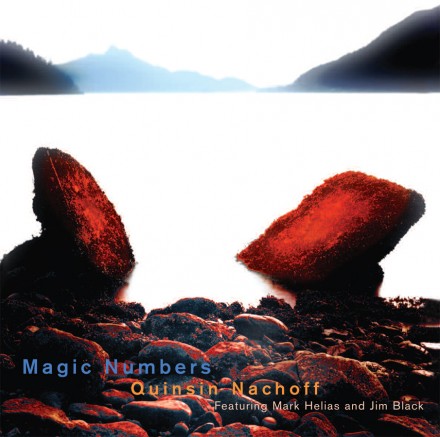Quinsin Nachoff
Magic Numbers
SGL SA1556-2“Nachoff is one of the truly bright younger jazz minds hereabouts…”
— Mark Miller, The Globe & Mail (Toronto)
Toronto saxophonist-composer Nachoff’s first Songlines release, several years in the making, combines the sax trio tradition of freewheeling improvisation and the discipline of a classical string quartet into an original aesthetic. Most of the music was composed before 2000, when Nachoff met and played with Jim Black at the Banff Centre (where he was coaching saxophone) and decided Black’s textures and grooves would be perfect for the music. That’s when he also met Montreal-based classical/jazz/world/pop violinist Nathalie Bonin, “who played this insanely difficult piece by Dave Douglas and made it sound effortless.” Later he became familiar with Mark Helias’s work, and eventually invited Black and Helias to Toronto to perform and record the music. Bonin chose the other string players from among Montreal’s young classical elite. “The big issue with classical musicians in a jazz or popular context particularly is time feel. The thing that differentiated this quartet from others was the ability to play very accurate time well, as opposed to playing behind the time, or tending to surround the time rather than playing right on beat.” With Helias acting as the bridge between the classical and improvisational worlds, Bonin sometimes improvising too (e.g. “Branches”), and Black often laying down a rockish 8th note beat, the music took on its definitive shape and emotional charge, with some great solos (e.g. Black’s in “Sun-Day,” as well as Helias’s solo with the strings). Nachoff’s saxophone inhabits the music’s melodic and harmonic heart, his singing lines demonstrating the expressive range, fluency and cohesion of a mature, thoughtful improviser.
The arrangements are often complex, the strings elegantly weaving together the music’s forms and textures in sometimes unexpected ways. As Quinsin writes in the liner notes, he was seeking a diplomatic blend of musical genres and styles which would nevertheless maintain the essence of melody and beauty. “I grew up listening to a lot of 20th century composers because my parents were really into that, starting with Stravinsky, Ravel, Debussy, going up to Stockhausen, Xenakis…I tried to cover quite a spectrum, sometimes within a piece and certainly across the album as a whole. The ballad ‘October’ is a really meditative, melancholy and austere tune. ‘Branches’ is frenetic. ‘To Solar Piazza’ tries to capture the angst and intensity of Astor Piazzolla’s music. ‘Circles & Waves’ is aiming for a fresh sort of romanticism along the lines of Kenny Wheeler and Maria Schneider. ‘Postmodern’ is crazier and more playful, little snippets of Mozart moments, free improv, Stravinsky, Shostakovich and rock all juxtaposed or squished together. ‘Whorls’ is much more serious, inspired by Berg and Schoenberg.”
Quinsin Nachoff has studied with Joe Lovano, Jim McNeely and Mike Murley among others. He was the winner of the 2004 KM Hunter Award in Music and a winner in the Canada Council Jazz I.D. Showcase. He toured Canadian jazz festivals with the music of his first CD, Quiescence, and organized a six-week tour of Australia, New Zealand, Japan and China, in addition to touring and recording with several Toronto or New York-based groups.
For more information: www.jimblack.com, www.markhelias.com, www.nathaliebonin.com
